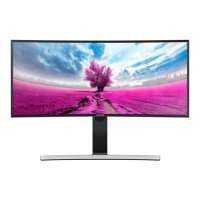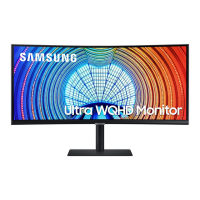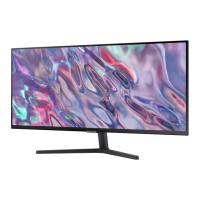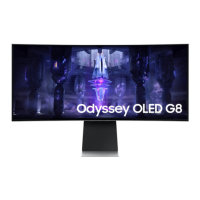
Do you have a question about the Samsung S34J552WQ Series and is the answer not in the manual?
| Screen Size | 34 inches |
|---|---|
| Resolution | 3440 x 1440 |
| Panel Type | VA |
| Refresh Rate | 75Hz |
| Aspect Ratio | 21:9 |
| Brightness | 300 cd/m² |
| Response Time | 4ms (GTG) |
| Connectivity | HDMI, DisplayPort |
| Contrast Ratio | 3000:1 |
| AMD FreeSync | Yes |
| Viewing Angle | 178°(H)/178°(V) |
| Stand Adjustments | Tilt |
| VESA Mount | 100x100mm |
| Color Support | 16.7 million colors |
| Ports | 2x HDMI, 1x DisplayPort |
| Dimensions (WxHxD) | 827.4 x 369.4 x 105.0 mm (without stand) |
Ensure adequate space around the product for ventilation and heat dissipation.
Important warnings and cautions to prevent injury or damage to the product.
Guidelines for storing the product to prevent damage or stains.
Instructions for safely cleaning the monitor's panel and exterior.
Crucial safety guidelines related to power usage and electrical connections.
Safety warnings and guidelines for installing the product correctly.
Important warnings and precautions for safe product operation.
Identification and description of the monitor's components.
Overview of the monitor's physical buttons and indicators.
Explains the shortcut button functions for quick access to settings.
Details on navigating the main menu and using function keys.
How to adjust key display settings using the JOG button initially.
Instructions on how to adjust the audio volume using the JOG button.
Description of the monitor's input and output connection ports.
How to adjust the monitor's tilt angle for optimal viewing.
Instructions on how to use an anti-theft locking device with the monitor.
Safe methods and precautions to follow when moving the monitor.
Detailed steps and notes for installing a wall mount or desktop stand.
Step-by-step guide on how to attach the monitor stand.
Step-by-step guide on how to remove the monitor stand.
Guidance on connecting a PC to the monitor for use.
Instructions for connecting the monitor via HDMI cable.
Instructions for connecting the monitor via HDMI-DVI cable.
Instructions for connecting the monitor via DP cable.
Steps to connect the monitor to a power source.
Recommendations for maintaining correct posture while using the monitor.
Guide for installing necessary drivers for optimal performance.
How to set the monitor to its optimal screen resolution.
Feature for optimizing picture quality based on environment.
How to adjust the general brightness level of the picture.
How to adjust the contrast between objects and background.
How to adjust the clarity or blurriness of object outlines.
Adjusting screen tint, saturation, and color tone settings.
Enhances picture details and vividness, especially for low-resolution content.
Optimizes picture quality for eye relaxation by reducing blue light.
Adjusts black level and contrast for HDMI input to correct image quality degradation.
Optimizes screen settings for gaming on PCs or consoles.
Accelerates panel response rate for vivid and natural video playback.
Minimizes input lag for faster reaction times during gaming.
Options to change the picture size and aspect ratio for different inputs.
Adjusting horizontal and vertical screen position in Screen Fit mode.
Enables or disables Picture-in-Picture (PIP) and Picture-by-Picture (PBP) modes.
Selects the size and aspect ratio for sub-screens in PIP/PBP modes.
Selects which sub-screen audio output to hear.
Selects the display position for the sub-screen in PIP mode.
Selects the input source for the main and sub-screens in PIP/PBP modes.
Selects the image size for sub-screens in PIP/PBP modes.
Sets the picture size for each divided screen in PBP mode.
Adjusts the contrast level for sub-screens in PIP/PBP modes.
Adjusts the transparency level of the menu windows.
Adjusts the position of the menu on the screen.
Sets the display language for the on-screen menu.
Sets how long the OSD menu remains visible before disappearing.
Technology to eliminate screen tearing and lag during gameplay.
Reduces energy consumption by adjusting brightness levels.
Configures automatic power-off timers for the monitor.
Sets the input mode for PC or AV devices for optimal picture display.
Selects the DisplayPort version for connection.
Automatically or manually detects the input signal source.
Controls the response rate of button presses.
Configures the behavior of the power indicator LED.
Resets all settings to their factory default values.
Displays current input source, frequency, and resolution.
Software for partitioning the monitor screen into multiple sections.
Potential issues and system requirements for installing the software.
Steps to take before contacting support for assistance.
How to perform a product test to diagnose issues.
Verifying screen resolution and frequency settings for compatibility.
Troubleshooting steps for audio problems, including no sound or low volume.
Diagnosing issues related to the connected input source, like PC booting sounds.
Frequently asked questions regarding frequency, resolution, and power-saving modes.
Overview of general specifications including model name, size, and power supply.
Lists standard signal modes, resolutions, frequencies, and pixel clocks.
Explains situations where service charges may apply even under warranty.
Lists issues that are not considered product defects and may incur service fees.
Details product damages resulting from customer mishandling or unauthorized repair.
Covers other scenarios for service charges, such as natural disasters or consumable use.












